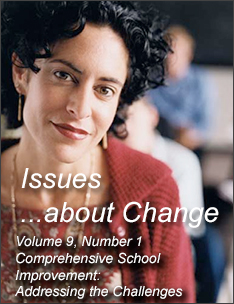What We Are Learning
SEDL staff conducted ongoing informal surveys, observations, and interviews, and documented each school's existing conditions with journal entries. In the process of reviewing the first year's work across all five sites, the researchers found five core issues, each of which had significant impact on the schools' past and present efforts at improvement:
- organizational structures,
- focus of improvement work,
- personal and social dynamics,
- contextual influences, and
- leadership.
While the school sites themselves were more dissimilar than similar, the five core issues were factors at each site, to varying degrees. Such commonalities motivated SEDL staff to examine more thoroughly the core issues and their impact on each of the schools.
Each of the core issues is thematic, encompassing a number of related areas in which the schools have needed assistance. The issues are highly interactive and interrelated, some to a stronger degree than others. Growth and progress at each site required that the external agent be aware of the five core issues. Actions were taken to nurture, support, and encourage positive developments within each of the core issues, in attempts to "build up" the capacity of staff and administration and to develop a system that is supportive of change.
Findings regarding these issues have evolved from the experiences, observations, and documentation of work done at the five sites by SEDL staff and by the shared observations and commentary of the school staffs.
This paper will clarify and discuss each core issue, using observations from the FIRST sites. While the situation in the schools with respect to these core issues does raise concerns, SEDL staff feel it is increasingly important to assess the overall picture, to acknowledge school staffs' weaknesses along with their strengths, in order to knowledgeably facilitate school change. While SEDL staff continue to work on these issues with schools, it is hoped that other external school improvement facilitators will benefit from the insights provided regarding the challenges that all schools may face as they undertake comprehensive reform.
1. Organizational Structures
With appropriate structures and processes in place, effective schools run efficiently. At the FIRST schools, many of the necessary organizational supports were lacking, and the result was disorganization, unclear directions and processes, few to no avenues for problem solving or  collaboration among staff, and frustrated teachers. Three specific areas within the organizational structures of schools were identified as areas that needed attention: time, communication, and organization.
collaboration among staff, and frustrated teachers. Three specific areas within the organizational structures of schools were identified as areas that needed attention: time, communication, and organization.
Finding time. One of the schools had regularly scheduled in-services for the whole staff to meet for professional development or collaboration. At the other four sites, faculty meetings were often held after school and were kept short to stay within state or union guidelines. Such meetings functioned primarily as a time to address administrative items, rather than to provide an opportunity for staff to come together as a whole for learning, problem solving, or decision making. The result was fragmented understanding of the schools' vision or collective purpose and continued isolation of teachers within their own classroom, grade level, and/or subject area.
Though in-service days and/or daily planning periods of 45 minutes or longer were scheduled at each school site, the staffs tended to use the time independently for grading, planning, etc. No times or structures were designated specifically to facilitate collaboration among teachers.
The inability to find time and/or the inefficient use of time greatly affected staffs' opportunities to discuss issues regarding their vision, their goals, the school, the students, and the curriculum. The result at each of the sites was a disconnection of purpose, intent, and action. Staff and administrators at each site identified a need for making time to work together as a staff and for using allotted time efficiently.
This particular issue required ongoing negotiation and creative problem solving between SEDL staff and the campus administrator(s). In some instances, the large size of the staff and limited time constraints have meant that only part of a staff was together at any one point. Within this configuration, the staffs were just learning how to use their time most productively so that their collective work has a positive impact on student learning.
Communication. Although all the schools could identify some form(s) of communication between administrators, staff, students, and parents, several of them did not have a regular means of daily or weekly communication of events. Rather, they relied on word-of-mouth messages and/or PA announcements, which were disruptive and frequently consumed valuable classroom instruction time. Each of the schools lacked efficient methods for regular, ongoing communication regarding events whether scheduled or unscheduled. Such inadequate communication often resulted in last minute scrambling on due dates, changes in staff or student meetings, and in hasty decision making.
At three of the schools in particular, information from the central office was not communicated to staff and/or administrators effectively or in a timely manner. Since much of the communication between schools and the central office is in the form of requests, concerns, or questions, the lack of efficient systems for such communication led to misinformation and confusion.
Several of the school sites did not have any consistent means of communicating calendar events to parents, and so parental involvement in school activities was limited. School stakeholders—the students, parents, and community members—were rarely informed of or invited to participate in school activities, especially those that required decision making. Teachers' contact with parents was generally in the context of reporting concerns or grievances regarding their students. Parents and surrounding community members were viewed as unsupportive of schools' efforts, and yet the staffs did not know how to nurture more positive relationships.
Organization. In the time that SEDL staff spent in the schools during the first year, it appeared that few organizational systems were in place for making requests, identifying concerns, allocating materials or resources, or handling necessary paperwork.
At one school site, it was not unusual for administrators to be unaware of a student's location during the day, since no system existed for accessing students' class schedules. If a parent came to pick up his or her child, or the administrator wanted to talk to a particular student, school office personnel would have to interrupt instructional time by making a call over the PA system asking the child to report to the office.
Most office personnel and administrators had not designed an efficient system for filing or accessing pertinent information, whether it was a state mandate regarding curriculum, personnel information, or student records.
2. Focus of Improvement Work
Maintaining an undeviating focus on students is central to identifying and articulating purposeful intent for any school's reform work. Such a focus was lacking at the sites. Often, small groups or individuals appeared to have a grasp of the overall intent of improvement  work at the sites, but staff-wide common focus and effort were not apparent.
work at the sites, but staff-wide common focus and effort were not apparent.
Also significant were the low levels of teacher empowerment found within these schools—teachers' ability and willingness to access information, identify needs and potential solutions, and engage in self-study were limited. The result was inconsistency of purpose, mixed messages, and inefficient implementation of instructional strategies across the sites. Four specific areas of need were noted this first year: data analysis, problem solving, access to information/resources, and conflict resolution/celebration.
Data analysis. SEDL staff involved each school staff in examining their school's strengths and areas of concern, engaging the entire staff in data collection, analyzing trends, and developing hypotheses. Four of the five sites found it difficult to provide recent student achievement data for this process, often not having the scores from the past year's assessments on hand at the school. Accessing longitudinal data for interpretation and analysis was even more difficult.
When SEDL staff did access student achievement data, the staff were not clear about the usefulness of information gained from examining these data.
Teachers and administrators exhibited limited understanding of alternative student assessment techniques, and this restricted their ability to accurately identify the needs of their students. Therefore, SEDL staff began to teach the school staffs how to interpret and analyze testing data. Once data were accessed, and teachers were taught how to read the scores and use them to identify strengths and needs, dialogue about the impact of instruction in the classroom began.
Collaborative problem solving. Beyond the examination of data is the opportunity for school staffs to engage in dialogue regarding the needs of their students and their school. Before establishing a partnership with SEDL, the five school sites had devoted little to no time to such discourse. As noted in the Organizational Structures section above, there was limited time provided for collaborative work. When administrators or staff attempted to discuss needs, it was often in a context of hurried decision making, without referring to data or acknowledging everyone's concerns.
Dialogue techniques—allowing everyone's voice to be heard without judgement—were not employed at any of the school sites. No clear norms were established for the school personnel to use in group discussions. The result was that a few vocal staff members at each school site were heard, while the rest of the group was quiet and less involved. Often the more vocal staff members were aware that not everyone was involved, and yet did not seem to know how to address the problem. On the other hand, the quieter, less involved staff members spoke of feeling alienated from the discussions and decision making, and therefore were admittedly less committed to "making things work."
The schools, in general, did not spend time identifying the potential for their students, their school, or themselves. Staffs were continually inundated by demands to improve student test scores, improve discipline referrals, or improve something else that was seen by someone else as unsatisfactory. School staffs did not spend any time identifying their strengths, or their vision for their students, schools, or themselves, and therefore they could not collectively relate to their successes or to their potential for improvement.
Access to information/resources/training. Only one of the schools had access to and made use of available technical assistance in the form of training or resources. The other sites have either had difficulty in the past accessing outside resources, were unaware of what assistance was available to them, or simply could not identify what kind of assistance would benefit them.
Directly related to the schools' need for a vision and goals for their improvement work, the schools' staff did not regularly seek information by tapping into research or literature regarding best practices. Staffs were more likely to attempt implementation of programs that another school in the district was doing, or what they heard from other teachers about what was working in their schools, rather than investigating the claims first.
School staffs often did not receive adequate training in the programs they were trying to implement. An example of this was the implementation of block scheduling at one high school. Though the block scheduling strategy was adopted three years ago, the staff never received training regarding their instructional practices while teaching in longer periods.
Conflict resolution and celebration. In any organization involving creative and energetic individuals, a certain degree of conflict will be present. Such friction does not result in negative attitudes or perceptions when there are clear norms and strategies for resolution in effect. These school sites, however, all struggled with conflict and they had limited resolution strategies in place. The results ranged from the development of factions within a school staff, to complete ignorance of conflict, to individuals' resigning their positions and leaving the school or district.
Celebration strategies were very limited at the school sites. Since the schools seldom acknowledged their progress, there was no apparent need to celebrate accomplishments, learning, or growth. When one high school's state assessment scores significantly increased this year, the SEDL staff member who had written congratulatory notes to the instructional teams was informed by teachers that the note was the only acknowledgment they had received upon learning of the improved scores. Without celebration of even the "little" things, staff motivation was low, which in turn affected the students' perceptions of school and learning, resulting in disenfranchised staff and students.
3. Personal and Social Dynamics
A trustful culture, mutual respect and regard within relationships, and collective engagement of staff and administrators are key components of effective cultures within schools. The personal  and social dynamics at these sites varied substantially.
and social dynamics at these sites varied substantially.
Trustful culture. Change of any kind is a very difficult process. SEDL staff recognize that when a group has personal or information concerns, it is unlikely that sustainable progress will be made until those concerns are resolved.
At some schools, the staff were open with each other, and a certain level of trust had been established over time. At other sites, however, the culture was distrustful—or at best, unsupportive—of staff-wide openness and respect. At each of the sites, there was the need for SEDL staff to establish norms with the group about working together and set some precedence regarding group involvement.
Several of the schools displayed a pervasive feeling of distrust toward district office staff. The causes of the distrust are unknown, but the lack of trust and respect significantly affected the ability of the staff to learn to work together with district staff.
Relationships. The development of a trustful culture requires strong professional relationships, and the key to developing those ties is to strengthen the personal relationships as well. Too often, the workplace is seen as the place for work, and there is no acknowledgment that everyone has a life "outside."
Each of the five school sites was limited in the development of relationships among staff members. There were very few opportunities, either within school or outside of it, for staff to do fun things together, learn together, laugh together, or just get to know each other. Relationships that were nurtured occurred primarily in small groups in grade level or subject area, because of proximity in location or similar scheduling. The groups that did engage in these types of interactions and relationship building worked more effectively together within the school as a result.
Collective engagement. Since the school staffs had had few experiences of working together in these schools, it is understandable that they had not had many opportunities to experience differences, develop mutual regard, or engage in collective learning.
Little to no work had been done with school staffs to acknowledge and value the differences in culture, experience, and expertise that they brought to the school environment. Due to the limited interactions between staff, opportunities for building trust and collegial growth were hindered. In several instances, pockets of staff members had worked together over a long period of time and had established some trusting relationships. In only a few instances, however, did staff use these relationships to engage in learning with and from each other regarding classroom practice.
4. Contextual Influences
A school does not operate separate or apart from surrounding entities. Four specific areas were found to have the most direct impact on the school staff and their improvement efforts: the  school itself, the community, the district, and the state.
school itself, the community, the district, and the state.
School context. The most apparent issue at two of the five sites was the quality and maintenance of the facilities and grounds. Each day students came to a school that was not well cared for, and the result was a continuing lack of respect for the facilities, displayed by ripped wallcoverings, beat-up lockers, trash on the floors, writing on the desks, and general classroom and hallway disrepair. Such an environment had become so common to school staff that little was done to address the issue of facilities maintenance, either among themselves, with the custodial staff, or with the students. Upon entering the buildings, one encountered an environment that was dismal, unkempt, and drab—not an atmosphere that would encourage positive self-esteem, communicate value and respect, or nurture pride.
Deeply intertwined with the context at the school sites was the quality of relationships between the students and the staff. At several of the schools these relationships were noticeably strained, and poor communication, behavior, and morale were the result.
In classes and while engaging in one-on-one conversation with students, teachers were frequently disciplining students rather than refocusing them on their work or encouraging their creativity in class. Students were overheard complaining about how the teachers treated them, and they rebelled by acting out in class or skipping classes altogether. There was significant emphasis on maintaining control through discipline. It was questionable, however, whether such tactics had the intended positive effects on student/staff relationships and student learning. Directly related was a comment made by staff and students alike: "We don't talk to each other." Since most students see their teachers more than they see their own parents, such unsupportive relationships can be detrimental to student learning, self-esteem, and personal growth.
In three of the five schools, there were significant attitudes and/or beliefs among the school staff affecting perceptions of students, parents, and community. Issues of culture, race, and education surfaced in many overt ways. Staff did not appear to acknowledge or understand the cultural beliefs or environmental situations of their students and community members. This affected the students' and their families' perceptions of the worthiness and value of the school and staff. Sometimes school staff communicated their own economic or educational superiority to students and parents, which further alienated the two groups and kept them from developing positive relationships and understanding.
Finally, the schools' teachers and administrators had low expectations with regard to themselves as professionals and as self-learners. This was communicated in many ways, but the most obvious to the teachers at several of the sites was the reality that resources, materials, and training were not available. Although each of these schools struggled with low funding for such items, teachers perceived the lack of supplies and opportunity as indications of disrespect for their work.
There were also low expectations held for the students as learners and for the district/community/state as viable support systems.
Community context. Every school functions within a community, which can maintain a limited understanding of the school, how it works, and what its impact is on students. The community comprises the parents of schoolchildren and also the area businesses that support and prosper from the education of the community's students. To varying degrees, each of the sites struggled with relationships within the community.
It was not uncommon to hear that the community held the school in less-than-supportive regard. Often articles appeared in the local media that reflected negatively on the school, the staff, or the students. Active community members and board members at several sites voiced their concerns about their schools' effectiveness publicly, which served to further deepen the divide between the school and the community. However, the school staffs engaged in little outreach to encourage more parental or community understanding. The general attitude of the school staffs seemed to be, "There's nothing we can do about it anyway."
Staff at each site discussed the importance of involving parents and community members, informing them of the work that is done at the school, and enlisting their assistance, but at most of the sites, staff experienced difficulty with this component and were unable to overcome their discomfort in working with parents and community members.
District context. Insofar as schools work within a larger system of education, they must be responsive to the requests, mandates, and desires of that surrounding system. District offices, charged with communicating state requirements, often make demands on schools regarding policies, curriculum, discipline, and professional development. With regard to policies, administrative demands, record keeping, facility maintenance, access to data, and availability of resources and materials, the numerous interactions between the schools and their district offices were less than smooth. Until the partnership with SEDL, most of these school sites took no action to improve the lines of communication between themselves and the district offices.
State context. The states' demands on these school sites either have changed significantly within the last few years (with the adoption of a new accountability system, for example), or are frequently changing. Therefore, clear communication of policies, adoptions, and mandates is very important. While district offices are often the voice of such communication, the inconsistency of messages and constant changes from the state departments continued to cause schools to struggle.
5. Leadership
The most critical of the themes emerging from the first year of work was the leadership capacity of the principals. Such administrative development includes the principal's ability to communicate a clear vision, inspire others to maintain high expectations,  create strong organizational systems for themselves and the school, understand what is possible regarding improvement, and develop a culture of mutual respect and regard. In other words, leadership capacity has significant impact and influence on the other four core issues.
create strong organizational systems for themselves and the school, understand what is possible regarding improvement, and develop a culture of mutual respect and regard. In other words, leadership capacity has significant impact and influence on the other four core issues.
Clear vision. Strong leadership is a necessary component for successful school reform. In order to provide such leadership, administrators need to be clear in identifying the vision they have for their school, their staff, their students, and themselves. The administrators at these sites simply held a common vision to "improve achievement scores."
Although this goal is certainly desirable for each of these schools, it was unclear how the administrators envisioned achieving it, and why that goal would be important—both necessary components of a strong vision. Without identifying a shared focus for improvement, administrators could not guide their staff in developing and articulating a collective vision for their students or their school. This lack of clarity made it difficult for the administrators to model the image through his or her actions with staff, students, parents, and community. Without a strong vision as a path toward improvement, the schools often "lost their way."
Expectations. Closely related to the vision are the expectations that a school leader communicates to his/her staff and students. At these school sites, high expectations were rare.
There is some relationship between the Personal and Social Dynamics and Contextual Influences in this subcategory, as expectations are often based on historical norms and professional relationships. In the case of one high school, the historical norms took precedence over the principal's desire to set higher expectations. Being a new principal, he deferred to the existing norms rather than establishing his own strong expectations directly related to a clear vision for improvement.
Several of the administrators at the sites spoke of high expectations for staff and students, but they rarely modeled or followed through on such expectations.
Decision making. As discussed in the Organizational Structures section, there were few clear procedures for decision making at the school sites. The absence of decision-making structures prevented teachers from being involved in long-range planning and resulted in unilateral decisions made by the administrator(s). If issues were brought to the staff, they were often "voted on" without accurate or thorough information.
Organization. School administrators at several of the sites had difficulty organizing the daily tasks and paperwork with a user-friendly system. It did not appear that office personnel were utilized effectively for organizational assistance, and it was difficult to locate something when it was needed for a teacher, a parent, or district office staff. This lack of organization was apparent in planning efforts, in meetings, and in daily work.
Systems for communication among staff and between school and home were also inadequate. Both of these forms of communication were mentioned in the Organizational Structures section.
Knowledge. One of the most important roles of a school leader is to function as a model for learning. It is imperative that administrators have a deep understanding of student learning and of teaching for learning, best practices, and current educational research. Such a foundation allows them to recognize and model strong teaching strategies for teaching staff. It is also important that administrators be familiar with state and district curriculum expectations and be able to communicate them to teachers and parents.
We found administrators to be willing to pursue their own learning in these areas, but too overwhelmed by the daily routine to devote any time to increasing their own understanding. Administrators who were involved in their own advanced studies were more likely to be current with best practice and aware of developing research. This strongly supports the idea that administrators need to pursue opportunities for their own professional growth, in order to increase the effectiveness of their leadership.
Administrators who valued continuous learning were more likely to make the connection between teacher efficacy and continuous improvement in their schools. They were also more likely to admit they didn't always have the right answers and to encourage teacher leadership among their staff. It is crucial that administrators be able to model the "will" to develop the "skill."
Culture. The role of the administrator includes nurturing a positive, learning culture of mutual respect and regard among staff setting high expectations, but it also requires commitment to the vision of such a culture.
At the schools studied, administrators did not address the culture among the staff and students. In some cases, they appeared oblivious to the needs of the staff or students, or unable to figure out how to respond to those needs. Some of the teachers felt that the principal didn't really know what was going on in classrooms, but should, and in some cases, students echoed that sentiment. These teachers wanted to see the principal around the school on a daily basis.
Administrators also needed to develop skills that would allow them to use resolution or mediation strategies appropriately in times of conflict, whether it was between students, parents, or staff. Too often, conflict was left to resolve itself and became detrimental to the school and/or the staff. Some of the unproductive norms at these sites had arisen from unresolved conflicts that were buried and in turn, had festered into a bigger issue.
Finally, the culture of a school includes the parents, and few administrators were comfortable or skilled in communicating clearly with parents and/or community members. In some instances, parents had been calling directly to the district office regarding issues or concerns, since they did not feel they received adequate responses from the school administrator.
Next Page: In Summary

